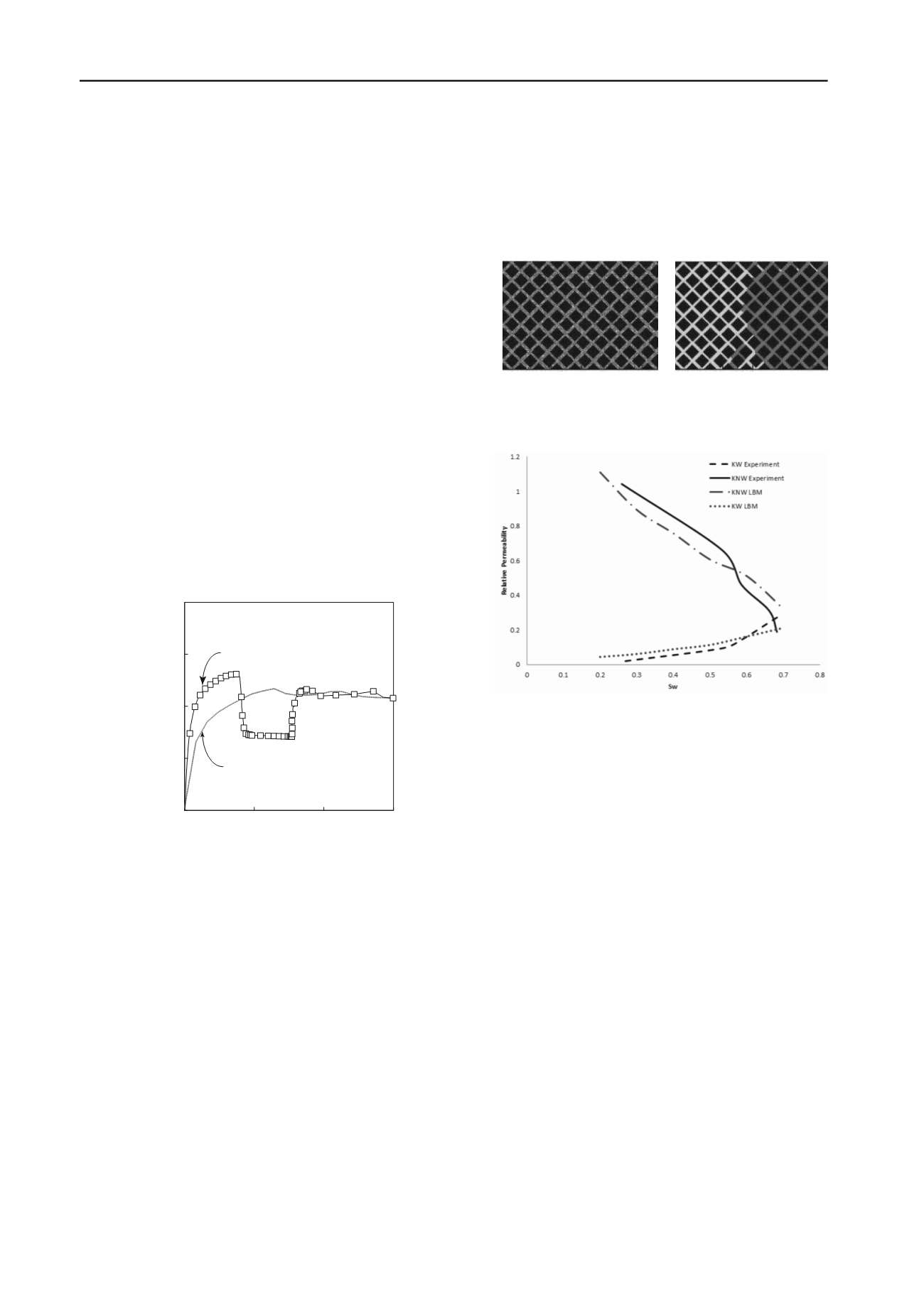
997
Technical Committee 105 /
Comité technique 105
The second paper related to energy production is the study
by
Hyodo et al. (2013),
who carried out a large laboratory
experimental campaign to determine the mechanical properties
and dissociation characteristics of sandy soils containing
methane hydrate. The testing devices include a high pressure
triaxial apparatus, capable of reproducing the in-situ conditions
expected during methane extraction. Moreover, a high pressure
and low temperature plane strain apparatus allowed the imaging
of (localized) deformation of methane hydrate bearing sand due
to methane hydrate production. Using this latter apparatus, two
tests were performed: plane strain compression and methane
hydrate dissociation by depressurization. The dissociation tests
were carried out in two different ways, either prescribing a pore
water pressure history corresponding to real production of
methane hydrate (Case 1), or by simulating the stress conditions
in the vicinity of the production well, where the material is close
to failure (Case 2).
This is a very interesting application, in which the micro-
scale physics (the methane hydrate bonding) is clearly driving
the behavior observed at the macro scale. The study certainly
lacks direct experimental observations at the micro scale – even
though the strain fields obtained by DIC can be considered as
measurements at a scale somewhere in between macro and
micro. By controlling the pressure (see Fig. 16) Hyodo and co-
workers nicely isolate the effect at the macro scale of a micro-
scale feature (cementation); in this respect, their contribution
fits very well the general theme of the session: from micro to
macro.
Fig.16. Effective stress ratio
vs
. axial strain during a dissociation test
for Case 2. Point (a) corresponds to the point before dissociation, and
point (b) to the point when pwp is decreased from 10MPa to 3MPa.
Point (c) corresponds to the point when MH is dissociated, and point
(d) to the point when the specimen failed due to an increase in pore
water pressure (re-pressurization) – note that failure occurred when
the stress path reached the strength of the host sand
(Hyodo et al.
2013)
.
Pak & Sheikh (2013)
present the 2D implementation of a Lattice
Boltzmann Method code that allows the simulation of
immiscible fluids (water and oil) flowing in porous rock – a
classical and central issue in petroleum geomechanics. The code
is validated against some basic test cases, and is then applied to
partially reproduce experimental results from Valavanides
et al
.
(1998) and Tsakiroglou
et al.
(2007) in both steady and
unsteady conditions. The comparison between experimental and
simulated results is encouraging and shows that the technique is
promising (see Figs. 17 and 18).
3.6
Contributions focusing on the macro scale
Heitor et al. (2013)
present an experimental study on
unsaturated silty sands, where materials compacted to different
levels are tested at different constant water contents in direct
shear. Even though the results of this experimental investigation
are justified by means of micromechanical arguments, this
remains a study at the macro scale only.
The contribution by
Zhou et al (2013)
deals with an
experimental evaluation of the effects of suction and
temperature on the cyclic behavior of soils – in particular the
resilient modulus. This is also a study at the macro scale only.
Figure 17. (left) example of initial distribution of the fluids in steady-
state simulation; (right) example of invasion of wetting fluid(green) in
unsteady state simulation
(Pak & Sheikh 2013).
0.0
0.5
1.0
0
5
10
15
Stress ratio (
'
1
-
'
3
)/(
'
1
+
'
3
)
Axial strain
a
(%)
Case2
(a)
(c)
(d)
(b)
S
MH
=0.0%
Figure 18. Comparison of Lattice Boltzmann modeling results and
experimental relative permeability curves (steady state)
(Pak & Sheikh
2013).
4 CONCLUSIONS
While our discipline has traditionally focused on the macro
scale, the papers submitted to this session show that a broad
spectrum of approaches, materials and techniques are now
becoming available to explore the behavior of geomaterials at
smaller scales. These tools are bringing new insights into the
physical processes driving the macroscopic behavior.
As our understanding of the micro behavior of geomaterials
progresses, it will be crucial to explicitly build a link between
the micro and macro scales – none of the contributions to this
session has yet accomplished this ambitious goal. As a matter of
fact, bridging the gap between micromechanical studies and
continuum approaches at the macro scale is one of the emergent
directions in mechanics and material science, not only in
geomechanics. This should be the central theme for discussion
in this session.
Multiscale methods have emerged recently in geomechanics
to bridge different material scales ranging from the micro scale
to continuum scale (
e.g
., Andrade
et al
. 2011, Nitka
et al
. 2011,
Frey
et al.
2013). These methods aim at obtaining constitutive
responses at the continuum scale, without resorting to
phenomenology. However, in most of these studies the multi-
scale character is essentially tackled at the modeling level,
involving theoretical and computational developments but
missing experimental input. In the writer’s opinion, experiments
should be an essential part of a multiscale approach – how else
can one make a realistic connection between micro scale
physics and macro scale responses?


